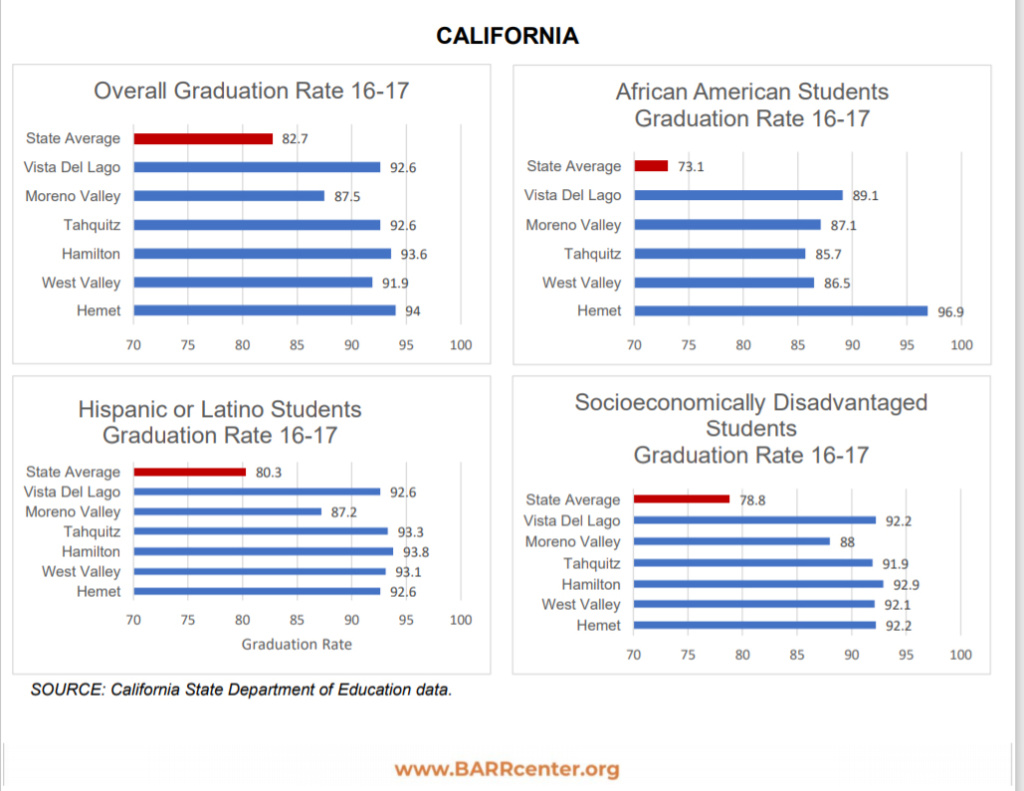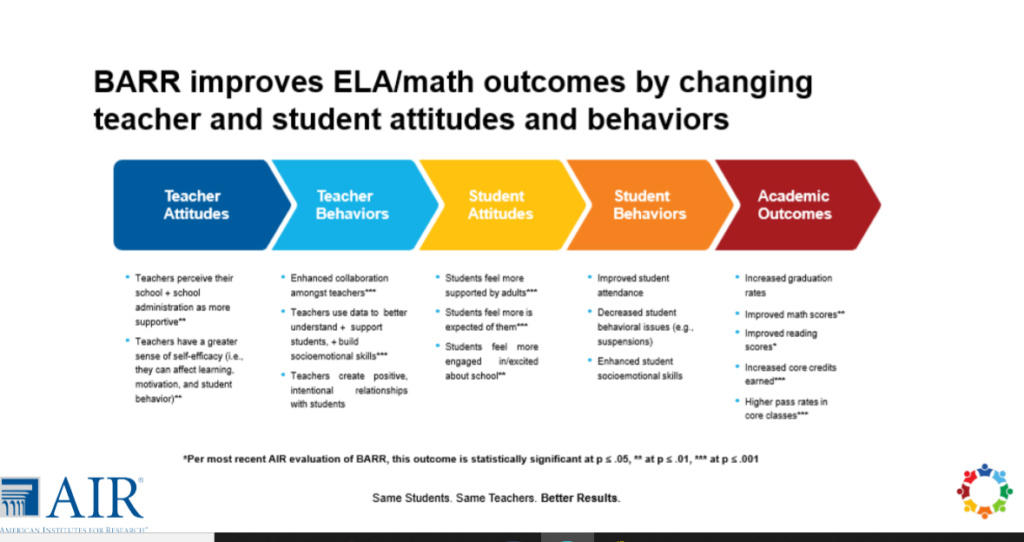
Study after study, at Federal and State level, is showing that the BARR Programme is increasing student graduation rates from High School by 40-45 per cent, including schools that hitherto were resistant to improvement.
It is showing equally impressive results in elementary schools (UK’s Primary phase) although the gains are measured in a different way. It is also occurring regardless of setting, be it smaller rural schools or large urban schools with entrenched ethnic minority under-achievement, according to rigorous random controlled trials.
The studies are causing intense excitement in the US, not least for their implications for the Black Lives Matter agenda, where black under-achievement has been a running sore in the US state schools system and an explosive political and social issue.
BARR was developed 22 years ago by a high school counselor who felt ineffective because more than 40% of her 9th grade students were failing at least one core course and were at risk of not graduating on time. She learned from her school’s principal that this was not just her high school’s problem, but it reflected a troubling national trend.
Using strategies from the fields of business and medicine, Executive Director Angela Jerabek created the BARR model and implemented it in the fall of 1998. By spring 1999, 9th grade student failure rate had decreased from 44% the previous year to 20%. Teachers worked together and knew each student – not just from an academic perspective, but from a personal perspective – their interests, strengths, hopes, and dreams.

Careful implementation and evaluation continued for ten more years, all with the same findings – students passed more classes, pursued more advanced courses, and 90 per cent graduating on time.
The BARR model uses eight interlocking strategies that build intentional relationships (staff to staff, staff to student, and student to student) and utilize real-time data to enable schools to achieve concrete academic, social and emotional outcomes for each student.
STRATEGY 1 – Focus on the whole student
In every interaction with – or discussion about – students, educators address students’ academic, emotional, social and physical needs. Teachers work to better understand and build on students’ strengths, proactively address the non-academic reasons why they may fall behind and identify what they need to thrive.
STRATEGY 2 – Provide professional development for teachers, counsellors, and administrators
BARR educators participate in yearly in-person trainings and coaching on promoting equity, reducing substance abuse, increasing meeting effectiveness and addressing trauma. These trainings begin prior to implementation and continue with daily, weekly, and monthly team meetings and unlimited remote support.
STRATEGY 3 – Use BARR’s I-Time Curriculum to foster a climate for learning
I-Time (U-Time for elementary/primary age children) is a weekly lesson that students take with others in their cohort (see below) as a supplement to the school curriculum. Facilitated by the cohort’s core-subject teachers. I-Time’s social/emotional focus helps students build strong relationships with teachers and each other – and practice essential life skills, such as communicating effectively and setting personal goals. I-Time also addresses grief and loss, bullying, and, for older students, substance use.
STRATEGY 4 – Create cohorts of students
In the BARR Model, students take a group of core courses as part of a block, or cohort. Each cohort typically has three core-subject teachers (typically math, English and science or social studies), and the teachers’ and students’ schedules are aligned so the students take these three core subjects only with other students in their cohort.
This structure helps educators cultivate connections – with students and with each other – that allow for more effective education. For example, in a school with an average of 30 students per class, a cohort typically would include three teachers and 90 students. Each of the three teachers (English, math and social studies, for example) would teach three 9th grade sections of his or her class – 30 students per class to make up the cohort of 90 students. In some schools, cohorts have four teachers.
STRATEGY 5 – Hold regular meetings of the cohort teacher teams
The teachers in a cohort have a shared meeting time. Teacher team meets weekly to discuss each student in the cohort using student-level data that is updated weekly. The teacher team evaluates each student’s progress as well as academic and non-academic barriers to learning. In these collaborative sessions, teachers identify students who are struggling and determine how to intervene to support them as well as students who should be accelerated. Each teacher provides a unique lens on the student and these perspectives combine during the meeting to create a more holistic view of the student.
STRATEGY 6 – Conduct risk review meetings
Cohort teacher teams identify the most at-risk students and move them into a structured Risk Review process that engages the community to determine the most effective response.
This team includes the school’s BARR coordinator, a school administrator, a school social worker/counsellor, and other professionals as needed. They are trained to use this process to identify and execute interventions to get essential external support for these students. Moreover, because the highest-risk students are getting additional support, the cohort teachers have more time for their students who need support but are not in crisis.
STRATEGY 7 – Engage families in student learning
BARR seeks to improve communication with families, treating them as active partners. Families are invited to participate in an initial orientation and to create a parent advisory council. Teachers also regularly call and meet with the families or guardians of students who need more support so the educators and families can share successes, assess challenges, and work together more effectively.
STRATEGY 8 – Engage administrators
As a school implements the BARR Model, administrators learn how they can integrate BARR into their school culture and use it to reach their specific school goals. Throughout the school year, administrators regularly communicate with and provide ongoing support to the BARR teams in their schools.
BARR – Building Assets, Reducing Risks – is a strengths-based model that provides schools with a comprehensive approach to meeting the academic, social, and emotional needs of all students. Schools within the BARR Network harness the power of relationships and data to become more equitable, ensure that no student is invisible, and remove both academic and non-academic barriers to learning.

What BARR does call for is a change in attitude so the focus moves from teaching a subject, to teaching young people. ‘Whereas for years we have assessed students to find gaps, holes in knowledge and deficiencies that must be remedied by teachers, the central question of BARR is,’ What are the student’s strengths’? says Director, Angela Jebarek. ‘Teachers will identify and focus on these to help the students to help themselves’.
It does also require some timetable reorganisation. ‘BARR’s model requires at least three 9th grade teachers from core academic areas to form a team that works with the same group of students. That means, for instance, the same students have English, math, and social studies together.’
Real Time Data
Real time data is a key aspect of BARR. Teachers are collating data about their learners all the time but BARR looks not just at attendance and behaviour, the grades they get in class and for homework. The team will also discuss factors outside the school, such as extracurricular interests, personal health, issues with other students, or troubles at home so they can build a picture of the student’s resilience and emotional health.
Data is not just for reporting or for dealing with crises. It lets the team spot potential issues before they affect happiness and progress. They can then work as a team and with the student to overcome challenges. Importantly, teachers do not just track problems but pinpoint and work with student strengths. This way they can identify achievable goals and help students get back on track.
It seems simple – the ideas are superficially simple. However, it’s the system of interventions, the training given to programme staff and then relayed to teachers and the structured nature of the relationships BARR insists upon in a school – usually accepted as givens and left to personal discretion and individual character – that are the real drivers.
Radical Re-orientation
It amounts to a radical re-orientation of attitude, atmosphere and culture in schools, with academic results become co-priorities of care and community.
If this seems a little soft focused, BARR entered a competition to win Federal grants in an Innovation in Education programme called i3. Its validation results with 11 in-school Random Control Trials in rural, urban, suburban locations – with 4,723 9th grade students and 149 teachers, was outstanding.
Their sample included Caucasian, Black and Hispanic students, as well as economically advantaged and disadvantaged students. Results showed that BARR students earned more core course credits, higher grade point averages and standardized test scores in mathematics and English Language Arts than students in the control group.
In addition, students reported more supportive relationships, higher rigor and expectations in classes, and higher levels of engagement in school than students in the control group. All of these academic and social-emotional increases were statistically significant when compared to the control group, and effect sizes were highest for students of colour, males, and economically disadvantaged students.
BARR teachers reported significantly higher levels of support by administration, a greater sense of self-efficacy, more collegiality, a better understanding of student behaviors, and more effective use of data than did teachers in the control group (Borman et al., 2020). In addition, our external evaluators, the American Institutes for Research (AIR) conducted a mediation analysis to better understand how the BARR model worked (Bos et al., 2019).
At the moment BARR has been awarded an i3 scale-up grant to conduct a large between school RCT with 66 schools across the United States – 33 schools randomly assigned to BARR and 33 schools randomly assigned to the control condition of business as usual.
This study is currently in its third year, but so far BARR has the unique distinction to be the only recipient in the US to earn all three stages of i3 Investing in Innovation grants: Development, Validation, Scale-Up. And this is why the Gates Foundation became so excited and invested $13 million in further research.
Register for free
No Credit Card required
- Register for free
- Free TeachingTimes Report every month